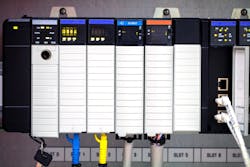Poorly Protected PLCs Lead to Production Line Problems
Programmable logic controllers (PLCs) have become the most popular and efficient way to control manufacturing equipment. Replacing the older style of hard-wired control relays, PLCs can be configured in software to construct logic or repair it. This is a great option for manufacturers to remotely troubleshoot and repair their equipment. PLCs also assist in speeding up automation in manufacturing, resulting in increased productivity and profits.
But what happens when this technology is effected by voltage sags? Depending on the vintage and manufacturer of the PLC, the result varies. Inevitably, the PLC will shut off, halting the production line. PLCs can shut off as fast as 1 cycle with 78% voltage remaining to 47 cycles with 59% voltage remaining. Many times, the PLC can lose its memory, requiring longer downtime to reprogram.
It is always prudent to apply a voltage sag mitigation technology to all PLCs. Uninterruptible power supplies (UPSs), ferroresonant transformers, and dynamic sag correctors all work to mitigate PLC errors and memory loss issues. What happens to all the other sensitive electrical controls and equipment that is controlled by the PLC? It is important to consider the entire manufacturing process to account for all possible ways the process can be stopped.
A tempered glass manufacturer was experiencing similar problems with their production line. When a voltage sag occurred, the entire process would shut down whenever the PLC would briefly lose power. The first recommendation, of course, was to protect the PLC. However, this was not the only issue. The engineer at the facility explained that when the PLC would lose power during a voltage sag, the sheet of glass moving through the tempering oven would stop. The oven would shut down when the natural gas burner lost power. (Caution: It is never advisable to mitigate any gas-fired equipment. Let it shut down as designed to avoid possible fire or explosion.) The oven would still be hot enough to melt the sheet of glass to the oven rollers. This caused a major maintenance problem to be corrected before any new glass could roll through the oven.
In this situation, the best solution would be to move the glass out of the oven before it melted. This can be accomplished by using a power quality sensing relay. The relay is designed to operate a set of contacts for voltage sag and swell. With the PLC mitigated, it would be possible to program logic to operate the oven rollers, pushing the glass out, when the power quality relay was activated.
This is a general idea that uses different power quality mitigation to achieve the most optimal result for the process. Solving power quality problems can become complicated, but the most simple approach can save time, money, and frustration.About the Author
Bryan Glenn
Power Quality Consultant
Bryan Glenn is a power quality consultant for EC&M magazine. He can be reached at [email protected].
